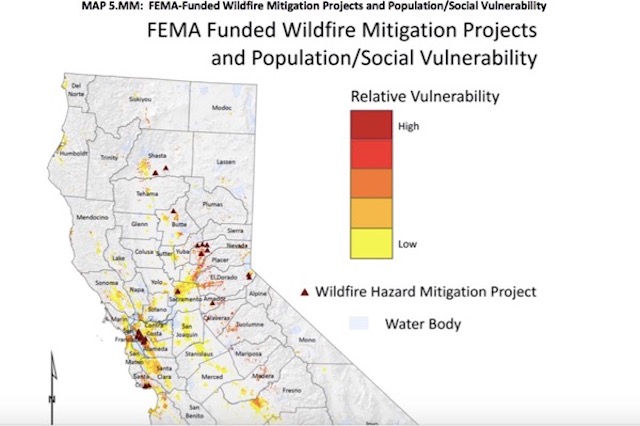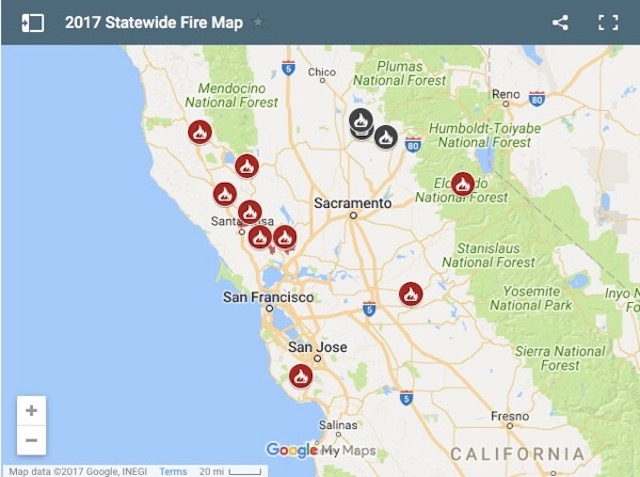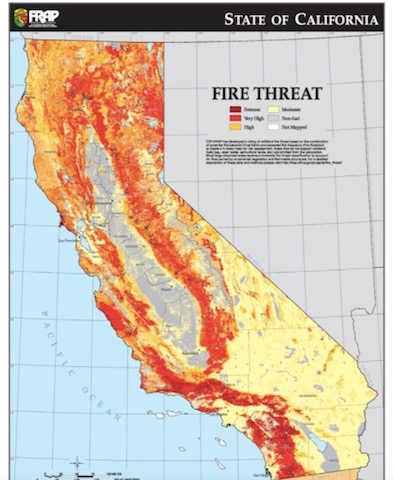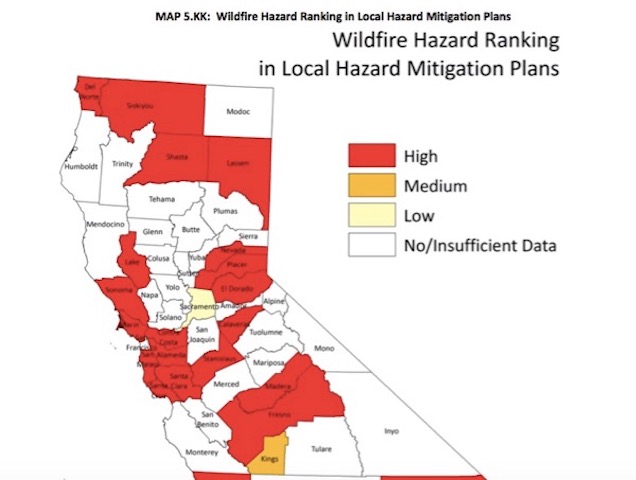Flawed Plan, Inadequate Resources, & Over-reliance on Local Government
My seat of the pants hypothesis is that the California Proposition 13 anti-tax, anti-government and anti-regulatory culture contributed to needless deaths and destruction.
Intro Note – With respect to wildfire protection, you’re on your own folks – read how the so called progressive State of California adopted a radical Ayn Rand individual responsibility approach that is expressly embedded in the California Hazard Mitigation Plan, which makes it clear that you’re on your own:
An informed, educated public that takes responsibility for its own decisions relating to wildfire protection (see plan and links below)
I’ve written a lot about the role of climate change in wildfires, so today will post a quick note – with the upfront caveat that I am not an expert on California and I have not adequately researched this issue – about the role of State Hazard Mitigation Planning.
Perhaps this superficial analysis and the questions I raise here might spur others to wade into those weeds.
In the massive press reports on the California wildfires, climate change is not the only major issue that is under-reported or not covered at all by the mainstream corporate media.
Here’s something important that you don’t see a lot of media coverage of:
Neither Napa nor Sonoma counties alerted residents of the fires through Wireless Emergency Alert (WEA) systems. Despite the fact that such technology is readily available, many of the dead and injured were caught sleeping, completely unprepared for what was coming. In some cases the victims did not hear horns or the desperate knocking of neighbors. Many rural residents beyond the reach of local police departments were left with no warning at all, their limited escape routes quickly engulfed by flames.
But the Washington Post reported yesterday that in neighboring Lake County, due north of Sonoma, local officials did send out an emergency blast that activated all cellphones, “turning them into the equivalent of squawking alarms.” Untold lives were saved by this activation of the WEA. Lake County is the only affected county that has reported zero fire deaths. ~~~ Why weren’t residents warned about the Northern California fires?
Why weren’t people warned? Why was the response and evacuation so bad?
Federal law requires that States prepare and submit Hazard Mitigation Plans to the Federal Emergency Management Agency (FEMA) as a condition of receipt of federal funds.
Here is a link to the California Hazard Mitigation Plan (HMP).
The objectives of that plan include an extensive discussion of wildfire risks and overall management (see Chapter 5 2013 SHMP Chapter 5 – Earthquakes, Floods, and Wildfires: Risks and Mitigation.
Noting that people died due to lack of warning and evacuation, the wildfire management framework seems to downplay early warning and evacuation and shift the burden to individuals and local government: (page 268)
Managing the human/wildfire conflict requires a commitment of resources and a focused mitigation plan over the long term. The approach must be system‐wide and include the following
- An informed, educated public that takes responsibility for its own decisions relating to wildfire protection
- An effective wildfire suppression program
- An aggressive hazardous fuels management program
- Land use policies and standards that protect life, property, and natural resources
- Building and fire codes that reduce structural ignitions from windblown embers and flame contact fromWUI fires and impede or halt fire spread within the structure once ignited
- Construction and property standards that provide defensible space
Without even reading the Plan, just looking at the various maps of the fires raise questions.
For example, compare the above map from the California HMP with the map below of the locations of wildfires – It sure looks like the counties with the worst wildfires (i.e Sonoma) are mapped as “low risk” in the California Plan based on FEMA.
But the FEMA funded risk map above conflicts with these State and local risk maps:
In scanning the HMP, it seems like California shares the same fundamental weakness of the NJ HMP – while California clearly addresses climate change while NJ does not, like NJ, California’s HMP has an over-reliance on and delegation to local governments for implementation and financing.
Here’s how California justifies the allocation of responsibility to State government:
State Responsibility Areas (SRAs)
State Responsibility Areas (SRAs) are those lands within California that meet specific geographic and environmental criteria. These are areas where CAL FIRE has legal and financial responsibility for wildland fire protection and where CAL FIRE administers fire hazard classifications and building standard regulations. SRAs are defined as lands that 1) are county unincorporated areas, 2) are not federally owned, 3) have wildland vegetation cover rather than agricultural or ornamental plants, 4) have watershed and/or range/forage value, and 5) have housing densities not exceeding three units per acre.55 Similar to the FRAs, where SRAs contain built environment or development, the responsibility for fire protection of those improvements (non‐wildland) is that of a local government agency.
Were the wildfires located in a State Responsibility Area? That last sentence suggests a local responsibility.
Who is responsible for paying? Again, we don’t get a clear answer in the California HMP:
Rule‐Making Authority and Financial Responsibility
The significance of the FRA, SRA, and LRA designations relates to the rule‐making authority and financial responsibility for fire protection. Local government agencies (cities and counties) typically control the authority to enact and enforce land use ordinances, building codes, and fire codes for development within their boundaries. This land use authority includes those areas where the local agency shares fire protection responsibility with either FRAs or SRAs. Financial responsibility for wildland fire protection is a significant issue because wildland fire protection is very expensive and considerably more expensive in WUI areas.
The California HMP very clearly anticipates the problem:
Urban Fire Conflagration Potential
Although this SHMP focuses primarily on wildfires, it recognizes urban conflagration, or a large disastrous fire in an urban area, as a major hazard that can occur due to many causes such as wildfires, earthquakes, gas leaks, chemical explosions, or arson. The urban fire conflagration that followed the 1906 San Francisco Earthquake did more damage than the earthquake itself. A source of danger to cities throughout human history, urban conflagration has been reduced as a general source of risk to life and property through improvements in community design, construction materials, and fire protection systems.
California also recently passed a law regarding wildfire:
5.4.4.2 LEGISLATION FOR LOCAL WILDFIRE HAZARD PLANNING
Progress Summary 5.T: Significance of Senate Bill 1241 Wildfire LegislationSenate Bill 1241: Wildfire Hazard Legislation
Safety Element
Planning and Zoning Law requires that cities and counties adopt a comprehensive general plan with various elements including a safety element for protection of the community from unreasonable risks associated with various hazards, including wildfires.
SB 1241 addresses local general plan safety elements (and all elements of a general plan, whether mandatory or optional, must be consistent with one another) in the following ways:
- Revises safety element requirements for state responsibility areas and very high fire hazard severity zones
- Requires local general plan safety elements, upon next revision of the housing element on or after January 1, 2014, to be reviewed and updated as necessary to address the risk of fire in SRAs and VHFHSZs
- Requires each safety element update to take into account the most recent version of the Office of Planning and Research’s “Fire Hazard Planning“ document
- Requires Office of Planning and Research (OPR), at the next update of its general plan guidelines, to include the provisions of SB 1241, or a reference to the provisions of SB 1241, as well as any other materials related to fire hazards or fire safety deemed appropriate for reference.
Local general plan safety element (and all elements of a general plan, whether mandatory or optional, must be consistent with one another) updates are required to include:
- Comprehensive review of local fire hazards in relation to distribution of existing or planned uses in SRA and VHFHSZ area within that jurisdiction
- Goals, policies and objectives for protection of the community from unreasonable risk of wildfire based on the identified fire hazard information
- Feasible implementation measures to carry out the defined goals, policies and objectives
- Attachment of or reference to any previously adopted fire safety plan that fulfills the goals of SB 1241
For any county containing SRAs or VHFHSZs, SB 1241 requires that the draft safety element update be submitted to the State Board of Forestry and Fire Protection and to every local agency that provides fire protection for the territory in the city or county for a 90 day review period prior to adoption or amendment of that safety element. Any recommendations provided by State Board of Forestry and Fire Protection or any local agency must be considered by the city council or county’s board of supervisors. Any rejection of recommendations must be communicated in writing to the State Board of Forestry and Fire Protection or local agency.
Progress as of 2013: This legislation is a significant addition to hazard mitigation efforts for wildfire areas because it follows the legislative model used in the 2007 flood legislation of hazard mitigation through state oversight of general plans. Similar to flood legislation adding flood plain planning responsibilities to local general plans (AB 162, etc.), SB 1241, passed in 2012, mandates wildfire planning responsibilities by local agencies through requirements regarding 1) wildfire updates to general plans; 2) mandatory findings for subdivision approvals in state responsibility areas (SRAs) and very high fire hazard severity zones (VHFHSZs); and 3) California Environmental Quality Act (CEQA) checklist updates for wildfire safety.
I urge some intrepid journalists out there to delve into this Plan and conduct a critical analysis of State’s role.
My seat of the pants hypothesis is that the California Proposition 13 anti-tax, anti-government and anti-regulatory culture contributed to needless deaths and destruction.





Pingback: WolfeNotes.com » From The Rooftops Of New Orleans To Paradise: Climate Chaos In Walmart Nation
Pingback: WolfeNotes.com » California’s PG&E Out-Blackmails NJ’s PSE&G